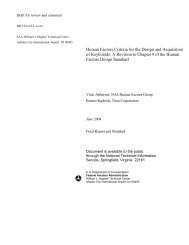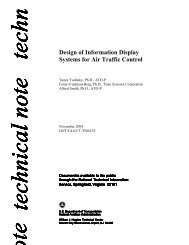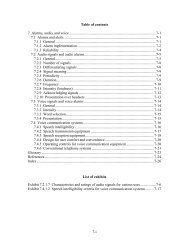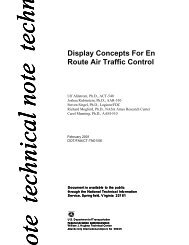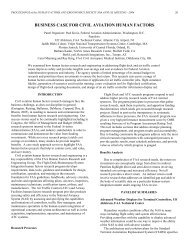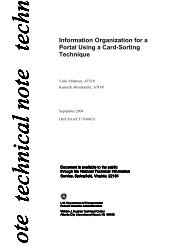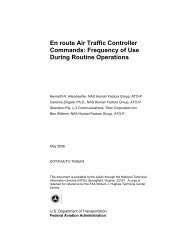Chapter 14. Anthropometry and Biomechanics - FAA
Chapter 14. Anthropometry and Biomechanics - FAA
Chapter 14. Anthropometry and Biomechanics - FAA
Create successful ePaper yourself
Turn your PDF publications into a flip-book with our unique Google optimized e-Paper software.
HFDS 2003 (amended Oct 2009)<strong>Chapter</strong> 14 <strong>Anthropometry</strong> <strong>and</strong> biomechanics<strong>14.</strong>4 ReachReach limits are clearly dependent on the task, motion, <strong>and</strong>function to be accomplished by the reach action. Limited reachdata on st<strong>and</strong>ard anthropometric positions are available insources of static <strong>and</strong> dynamic anthropometric data. Reachenvelopes need to be constructed for actual working positions<strong>and</strong> for explicit design purposes. Reach envelopes may berelated to a body reference point (such as the shoulder joint), to ameasurement apparatus point, or to a design point (such as a seatreference point). This section provides design criteria <strong>and</strong> rulesfor using reach data <strong>and</strong> constructing reach envelopes. [Source:NASA-STD-3000A, 1989]• <strong>14.</strong>4.1 Task <strong>and</strong> body position effects. The following taskconsiderations shall be taken into account in order to establishreference points <strong>and</strong> to obtain the reach information needed toconstruct a reach envelope:a. the nature <strong>and</strong> requirements of the task to be performed(see also Paragraphs <strong>14.</strong>3.1.2 <strong>and</strong> <strong>14.</strong>4.3 for the nature ofthe reach task),b. body position while reaching (st<strong>and</strong>ing, seated, seat back<strong>and</strong> seat pan angles, <strong>and</strong> others),c. whole body movement capabilities <strong>and</strong> restraints (seatbelts, harnesses, necessary <strong>and</strong> permitted movements ofthe torso),d. design purposes such as: to accommodate the appropriateportion of the population, to enhance task performance, orto avoid striking reachable surfaces, <strong>and</strong>e. equipment locations that interfere with reach, vision orintercommunications. [Source: NASA-STD-3000A, 1989]14-35



